We’re often asked if it is possible to mow a lawn with a scythe. The answer is yes and there are many people in the UK doing just that! Lawn mowing can be a test of a scythers skill, it takes some thought and practice to do well. Here is a summary of the factors you need to consider if you are thinking of scything a lawn.
Part 1 is about your lawn; Part 2 will be about your scythe and blade; and Part 3 about scything techniques for short grass. With a bit of practice, you don’t really need the plastic, resource use, electricity and noise involved with lawn-mowers.
Lawns and the scythe – a brief history
Lawns as we know them arose in 17th century England at the homes of large, wealthy landowners.
Beyond the ha-ha, vegetation was controlled with livestock. Close to their homes landowners employed teams of scythers to create close cropped lawns. Only the rich could afford to pay for the labour needed, so a lawn was a mark of wealth and status.
Lawn mowing – the challenges
- In general, shorter grass is harder to mow then long grass. It is softer, more pliable and more inclined to bend away from the blade, so it requires better scything and sharpening technique to cut it well.
- Lawns often have a lot of foot traffic, so at least some of the grass will be bent over and lying in lots of different directions. Choosing how to set up your scything takes a little more thought.
- Grass species can also play a part. What is your lawn made of? Thin, dry wiry grasses are more challenging to cut then lusher, broader leaved ones.
- Given the above challenges, how can we make it easier to scythe a lawn.
Making it easier – change your expectations
As short grass is more challenging to mow, letting your lawn grow longer between mowings will help your learning process a lot. Have a look at the area you are planning on mowing. Do you need a bowling green finish across the whole lawn? Can you leave it longer between mowings? If the area is large, can you divide it up and mow parts of it at different intervals?
Decreasing the frequency of mowing and rotating the areas that you mow will make the task easier. You will have less to mow in any one session and it is beneficial to wildlife too. The wildlife charity Plantlife are encouraging gardeners to think about how they manage their lawns with the No Mow May campaign. Interestingly, you do not need to leave it long and wild to see wildlife benefits.
The highest production of flowers and nectar sugar was on lawns cut once every four weeks. This gives ‘short-grass’ plants like daisies and white clover a chance to flower in profusion, boosting nectar production tenfold.
Areas of longer unmown grass were, however, more diverse in their range of flowers, with other nectar-rich plants like oxeye daisy, field scabious and knapweed increasing the range of nectar sources for different pollinators and extending nectar availability into late summer.
Plantlife, No Mow May Citizen Science Project
As a result of their citizen science project Plantlife recommend:
- Leaving some areas of your lawn unmown to let taller plants flower.
- Mowing the rest of the lawn once a month. Ideally, rotate the patches that you mow so that there are always some areas in flower.
Of course, this kind of management is ideally suited to the scythe. There’s no need to worry about longer grass clogging up your mower – the scythe can handle it easily!
How we manage our lawns and paths
We have a small lawn in our private garden, a larger one by the Trust barn and various paths and tracks that are kept mown throughout the growing season.
- No part of this is mown more then six times between April – November.
- A lot of the paths and tracks are only mown four times over this time period, but this is enough to keep them in good condition.
- Some areas are mown just once a season.

Choosing when and how you mow
Scythes are not like lawn mowers – it is easier to mow damp grass rather then dry. So the time of day you mow can have a big influence on your mowing.
Early in the morning whilst the dew is still on the grass is ideal, else on a drizzly damp day or in the evening as the dew falls. It’s not entirely clear why it’s easier to scythe damp grass. Factors might include a lubricating effect of the moisture on the blade as it slices through the grass and a difference in the sap pressure, and therefore the hardness of the grasses.
When thinking about how to mow your lawn, it is easier to follow the way the grass is lying rather then trying to mow in straight lines.
Look carefully at how the grass is lying and mow so that it is leaning away from you and towards the right.
Change direction as often as is needed to follow the lie of the grass – you’ll probably end up with lovely sinuous windrows.
Next week: Part 2 – choosing and maintaining your scythe.

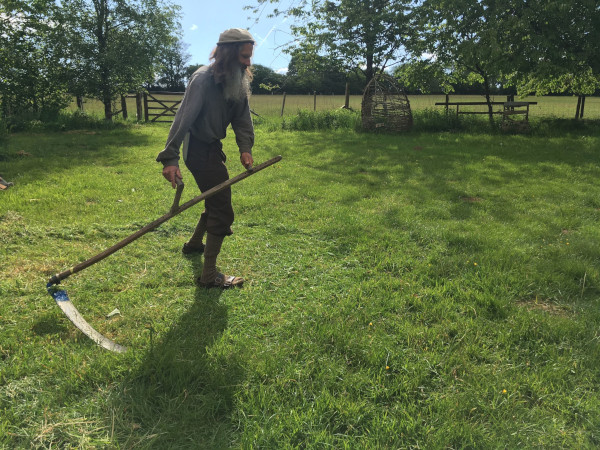
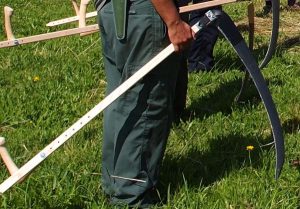
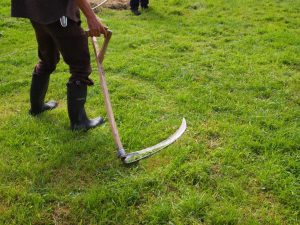

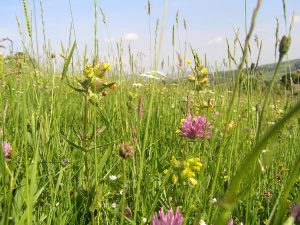
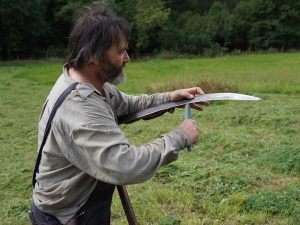
5 Comments
This is something I’d love to have a go at. I have a push mower but it limits how long u can let the grass grow before needing another option. I just hate the noise of electric or motor mowers and this article has come along just as I’ve been wondering hard about getting one and learning how to use it.
Interesting, very interesting. Just before the present cull started (Covid 19 Pandemic – get rid of unwanted ‘umans) I got myself a scythe, ever now and again I foray into the garden and have some fun. I’m nowhere near an expert yet, the lawn / grass bit out the back looks a bit like me – bald in some places, long haired in others but at least it is generally shorter AND wildlife gets to play in it! It is fun and you do get a nice sense of happiness afterwards if slightly (I lie) tired afterwards. There are no dobut better ways to taking up the habit but I enjoy it the way I am doing it, more importantly not much damage is being done to the environment – to anybody thinking of this, please have a go, strongly recommended. I believe there are country shows now where you can watch somebody doing it properly (i.e. not me) you might even get to have a go, but yet again do have a try!
the Walrus
Mike – yes, and there are courses too – https://www.lowimpact.org/directory/categories/scything-courses
Let us know how you get on (especially when it comes to keeping it sharp).
ah Dave, you are taking the fun out of it – courses indeed? However if I do go that way I will certainly let you and lowimpact know how I do! As for sherpening, once you’ve got used to peaning (that can be a bit of fun) waving a sharpening stone over the blade every “swipes” at the grass [as longs as you manage to remember that – the blade gets blunt fairly quickly it seems] Life becomes fun – oh yes and it’s a great talking point stood in the corner of the lounge when not in use! He He He!
Hello! I am very interested in learning to use a scythe to mow my lawn. I have zoysia grass with some weeds. They say it should be mowed to 1.5 – 2 inches. Are scythes able to handle that height? Or do they mow closer to the ground? I don’t want to scalp or kill my lawn, but I love the idea of mowing with a scythe that “cranks” every time I want to use it!